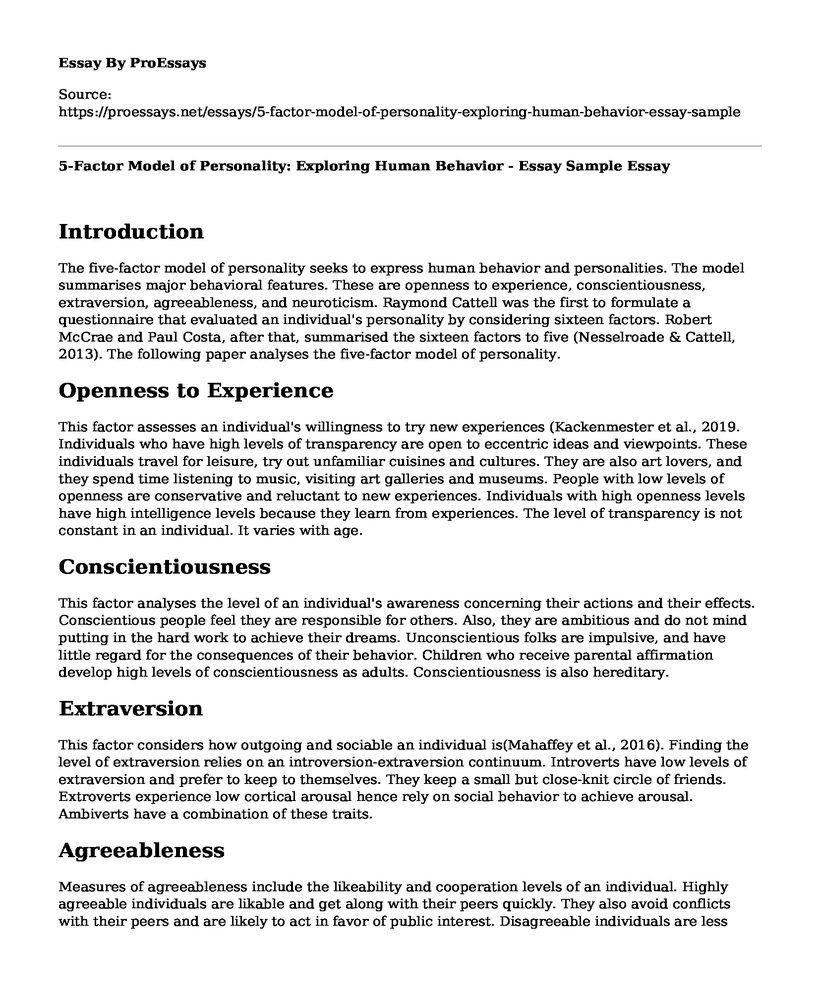Introduction
The five-factor model of personality seeks to express human behavior and personalities. The model summarises major behavioral features. These are openness to experience, conscientiousness, extraversion, agreeableness, and neuroticism. Raymond Cattell was the first to formulate a questionnaire that evaluated an individual's personality by considering sixteen factors. Robert McCrae and Paul Costa, after that, summarised the sixteen factors to five (Nesselroade & Cattell, 2013). The following paper analyses the five-factor model of personality.
Openness to Experience
This factor assesses an individual's willingness to try new experiences (Kackenmester et al., 2019. Individuals who have high levels of transparency are open to eccentric ideas and viewpoints. These individuals travel for leisure, try out unfamiliar cuisines and cultures. They are also art lovers, and they spend time listening to music, visiting art galleries and museums. People with low levels of openness are conservative and reluctant to new experiences. Individuals with high openness levels have high intelligence levels because they learn from experiences. The level of transparency is not constant in an individual. It varies with age.
Conscientiousness
This factor analyses the level of an individual's awareness concerning their actions and their effects. Conscientious people feel they are responsible for others. Also, they are ambitious and do not mind putting in the hard work to achieve their dreams. Unconscientious folks are impulsive, and have little regard for the consequences of their behavior. Children who receive parental affirmation develop high levels of conscientiousness as adults. Conscientiousness is also hereditary.
Extraversion
This factor considers how outgoing and sociable an individual is(Mahaffey et al., 2016). Finding the level of extraversion relies on an introversion-extraversion continuum. Introverts have low levels of extraversion and prefer to keep to themselves. They keep a small but close-knit circle of friends. Extroverts experience low cortical arousal hence rely on social behavior to achieve arousal. Ambiverts have a combination of these traits.
Agreeableness
Measures of agreeableness include the likeability and cooperation levels of an individual. Highly agreeable individuals are likable and get along with their peers quickly. They also avoid conflicts with their peers and are likely to act in favor of public interest. Disagreeable individuals are less trusting and charitable. They are often alone and have poor relationships (Widiger, 2017). Agreeable levels increase with age.
Neuroticism
This trait measures the emotional stability levels of individuals. High neuroticism levels result in anxiety, obsessing over problems, and inflating their implications. They are often pessimistic and have a fear of failure and punishment. Individuals exhibiting low neurotic levels worry less and do well when under stress. Individuals with low neurotic levels have problems holding onto relationships.
Conclusion
In conclusion, the five-factor model offers excellent benefits to the psychology field. Through the five traits, psychologists have been able to link career performance and job satisfaction and performance (Salgado, 1997). It also offers a simple process to identify personalities.
References
Kackenmester, W., Bott, A., & Wacker, J. (2019). Openness to experience predicts dopamine effects on divergent thinking. Personality Neuroscience, 2. https://doi.org/10.1017/pen.2019.3
Mahaffey, B. L., Watson, D., Clark, L. A., & Kotov, R. (2016). Clinical and personality traits in emotional disorders: Evidence of a common framework. Journal of Abnormal Psychology, 125(6), 758-767. https://doi.org/10.1037/abn0000187
Nesselroade, J. R., & Cattell, R. B. (2013). Handbook of Multivariate Experimental Psychology. Springer Science & Business Media.
Salgado, J. F. (1997). The five factor model of personality and job performance in the European Community. Journal of Applied Psychology, 82(1), 30-43. https://doi.org/10.1037/0021-9010.82.1.30
Widiger, T. A. (2017). The Oxford Handbook of the Five Factor Model. Oxford University Press.
Cite this page
5-Factor Model of Personality: Exploring Human Behavior - Essay Sample. (2023, Apr 24). Retrieved from https://proessays.net/essays/5-factor-model-of-personality-exploring-human-behavior-essay-sample
If you are the original author of this essay and no longer wish to have it published on the ProEssays website, please click below to request its removal:
- Discrimination Against People With Mental Health Problems
- Soft Power Influence Essay
- Christian Counselling Essay
- Psychotherapy: A Path to Healing Trauma, Coping & Mental Disorders - Research Paper
- Paper Example on Tom Walker: A Mental Illness Care Plan
- Free Essay Example: Transitioning from Childhood to Adolescent Self-Concept
- Mental Illness and Homelessness - Free Report Example







